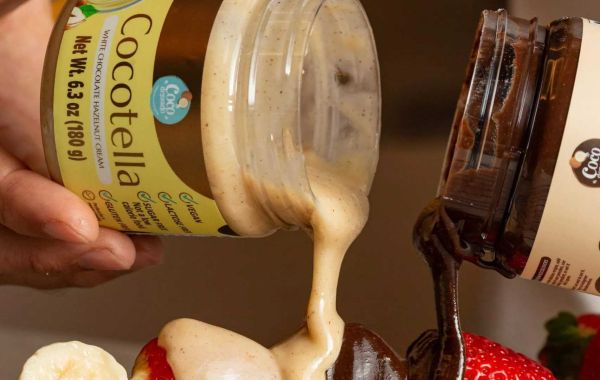The demand for homemade dessert spreads has been on the rise in recent years as people become more conscious of the ingredients they consume. These delectable spreads offer a healthier alternative to store-bought options, allowing you to indulge in delicious treats without compromising on nutrition. In this article, we will explore the world of homemade dessert spreads, their health benefits, essential ingredients, equipment needed, popular varieties, step-by-step guide to making them, tips and tricks, creative usage ideas, and answer some frequently asked questions.
The Rise of Homemade Dessert Spreads
Homemade dessert spreads have gained immense popularity due to their versatility and nutritional value. Unlike commercially produced spreads, homemade versions provide greater control over the ingredients used, ensuring a healthier outcome. With the rise of food allergies and dietary restrictions, homemade dessert spreads allow individuals to tailor recipes according to their specific needs.
Health Benefits of Homemade Dessert Spreads
Rich in Nutrients
Homemade dessert spreads are packed with essential nutrients derived from nuts, seeds, and other wholesome ingredients. These spreads are an excellent source of healthy fats, protein, fiber, vitamins, and minerals. By incorporating them into your diet, you can enjoy a nutrient-rich treat that nourishes your body.
Control Over Ingredients
One of the significant advantages of making homemade dessert spreads is having complete control over the ingredients. You can select high-quality nuts, seeds, sweeteners, and flavor enhancers without any additives or preservatives. This allows you to create a spread that aligns with your dietary preferences and health goals.
Customizable Flavors
When making your own dessert spreads, you have the freedom to experiment with various flavors and textures. From classic combinations like almond butter and peanut butter to unique blends like cashew butter and hazelnut spread, the possibilities are endless. You can add spices, extracts, or even fruits to create a personalized flavor profile that suits your taste buds.
Essential Ingredients for Homemade Dessert Spreads
To create delicious and nutritious homemade dessert spreads, it's essential to gather the right ingredients. Here are the key components you'll need:
Nuts and Seeds
The base of most dessert spreads consists of nuts or seeds. Popular options include almonds, peanuts, cashews, hazelnuts, and sunflower seeds. These ingredients provide the creamy texture and distinct flavor that make spreads so irresistible.
Sweeteners
Sweeteners play a crucial role in balancing the flavors of homemade dessert spreads. You can choose from natural sweeteners like honey, maple syrup, or agave nectar. For a sugar-free option, you can use stevia or dates, which provide natural sweetness.
Flavor Enhancers
To enhance the taste of your homemade dessert spreads, consider adding flavor enhancers such as vanilla extract, cinnamon, cocoa powder, or sea salt. These ingredients add depth and complexity to the final product.
Equipment Needed for Making Homemade Dessert Spreads
Before diving into the world of homemade dessert spreads, it's important to have the right equipment on hand. Here are the essential tools you'll need:
Food Processor or Blender
A reliable food processor or blender is crucial for achieving a smooth and creamy consistency in your spreads. It effectively breaks down the nuts or seeds, creating a velvety texture.
Airtight Containers
To maintain the freshness and longevity of your homemade dessert spreads, store them in airtight containers. Mason jars or glass containers with lids work well for this purpose.
Popular Varieties of Homemade Dessert Spreads
Homemade dessert spreads offer a wide range of flavors to satisfy every palate. Here are some popular varieties you can try making:
Almond Butter
Almond butter is a classic and nutritious spread made from roasted almonds. It has a rich, creamy texture and a slightly sweet taste. Almond butter is versatile and can be used in various recipes or simply spread on toast.
Peanut Butter
Peanut butter is an all-time favorite spread loved by many. Made from roasted peanuts, it provides a nutty and savory flavor. Peanut butter is a pantry staple and can be used in sandwiches, baked goods, or enjoyed straight from the jar.
Cashew Butter
Cashew butter offers a smooth and velvety texture with a mild, buttery taste. It pairs well with fruits, crackers, or can be used as a base for creamy sauces and dressings.
Hazelnut Spread
Hazelnut spread, famously known as a chocolate-hazelnut spread, is a delightful treat loved by chocolate enthusiasts. It combines the richness of roasted hazelnuts with the sweetness of cocoa, resulting in a luscious spread that can be used in various desserts or enjoyed on its own.
Sunflower Seed Butter
Sunflower seed butter is an excellent alternative for those with nut allergies. It offers a mild and nutty flavor, making it a suitable choice for individuals with dietary restrictions. Sunflower seed butter can be used as a spread or incorporated into recipes that call for nut butter.
Step-by-Step Guide to Making Homemade Dessert Spreads
Now that you're familiar with the essentials let's dive into the step-by-step process of making homemade dessert spreads:
- Selecting and Preparing Ingredients
Gather your preferred nuts or seeds and ensure they are fresh. If necessary, roast them in the oven to enhance their flavor and aroma. Let them cool before proceeding.
- Blending the Ingredients
Place the nuts or seeds in a food processor or blender. Blend until they break down into a smooth paste. You may need to scrape down the sides occasionally to ensure even blending.
- Adjusting Consistency and Flavor
At this stage, you can add sweeteners, flavor enhancers, and a pinch of salt if desired. Blend the mixture again until well incorporated. If the spread seems too thick, you can add a small amount of oil (such as coconut or avocado oil) to achieve the desired consistency.
- Storing the Spread
Transfer the homemade dessert spread into clean, airtight containers. Store them in a cool, dry place or in the refrigerator, depending on your preference. Proper storage will ensure the spread remains fresh and flavorful.
Tips and Tricks for Perfect Homemade Dessert Spreads
To elevate your homemade dessert spreads, here are some tips and tricks to keep in mind:
- Roasting Nuts and Seeds: Roasting nuts or seeds before blending intensifies their flavors and provides a richer taste to your spreads. Spread them evenly on a baking sheet and roast in the oven at a low temperature until golden brown.
- Experimenting with Flavors: Don't be afraid to get creative with your spreads. Add different spices like ginger, cardamom, or nutmeg to create unique flavor profiles. You can also incorporate dried fruits or even a swirl of melted chocolate for a decadent twist.
- Achieving Desired Consistency: If your spread is too thick, you can add a small amount of oil or liquid sweetener to thin it out. Conversely, if it's too runny, you can add more nuts or seeds to thicken the consistency.
Creative Ways to Use Homemade Dessert Spreads
Homemade dessert spreads are incredibly versatile and can be used in numerous ways. Here are some creative ideas to enjoy your spreads:
- Spreading on Toast or Crackers: Classic but always delightful, spread your homemade creation on warm toast or crisp crackers for a quick and satisfying snack.
- Incorporating in Baked Goods: Use your spreads as an ingredient in cookies, brownies, or cakes to add a unique flavor twist. They can also be swirled into muffin or pancake batter for an extra touch of indulgence.
- Adding to Smoothies or Yogurt: Blend a spoonful of your homemade dessert spread into your morning smoothies or mix it into yogurt for a delightful and nutritious boost.
- Drizzling on Fruits: Elevate the flavor of fresh fruits by drizzling them with your homemade spread. It pairs exceptionally well with apples, bananas, strawberries, and even citrus fruits.
Frequently Asked Questions (FAQs)
- What is the shelf life of homemade dessert spreads?
Homemade dessert spreads can generally be stored for several weeks to a few months, depending on the ingredients used. It's best to check for any signs of spoilage before consuming.
- Can I use alternative sweeteners in homemade spreads?
Yes, you can experiment with different sweeteners like stevia, dates, or coconut sugar to suit your dietary preferences or if you're looking for a sugar-free option.
- How can I make my spread thinner?
If your spread is too thick, you can add a small amount of oil or liquid sweetener to achieve the desired consistency. Mix well until the spread reaches your preferred texture.
- Are homemade dessert spreads suitable for people with nut allergies?
Homemade dessert spreads can be adapted to accommodate nut allergies by using alternative options such as sunflower seeds or pumpkin seeds. However, it's important to ensure the chosen ingredients are safe for consumption.
- Can I freeze homemade dessert spreads?
Yes, homemade dessert spreads can be frozen to extend their shelf life. Ensure you use airtight containers or freezer bags and thaw them in the refrigerator before use.
Conclusion
Homemade dessert spreads offer a delicious and nutritious way to indulge in sweet treats. By making your own spreads, you have control over the ingredients, flavors, and textures. Whether you prefer classic varieties like almond butter and peanut butter or want to explore unique blends, the possibilities are endless. Experiment with different combinations, adjust flavors to your liking, and enjoy the satisfaction of creating wholesome spreads from scratch.
FAQs (with Answers)
Q: What is the shelf life of homemade dessert spreads?
A: Homemade dessert spreads can generally be stored for several weeks to a few months, depending on the ingredients used. It's best to check for any signs of spoilage before consuming.
Q: Can I use alternative sweeteners in homemade spreads?
A: Yes, you can experiment with different sweeteners like stevia, dates, or coconut sugar to suit your dietary preferences or if you're looking for a sugar-free option.
Q: How can I make my spread thinner?
A: If your spread is too thick, you can add a small amount of oil or liquid sweetener to achieve the desired consistency. Mix well until the spread reaches your preferred texture.
Q: Are homemade dessert spreads suitable for people with nut allergies?
A: Homemade dessert spreads can be adapted to accommodate nut allergies by using alternative options such as sunflower seeds or pumpkin seeds. However, it's important to ensure the chosen ingredients are safe for consumption.
Q: Can I freeze homemade dessert spreads?
A: Yes, homemade dessert spreads can be frozen to extend their shelf life. Ensure you use airtight containers or freezer bags and thaw them in the refrigerator before use.








